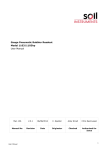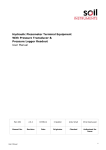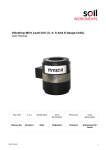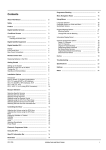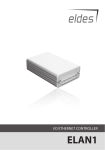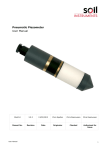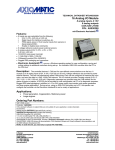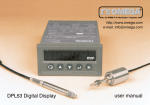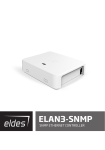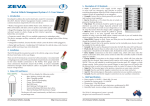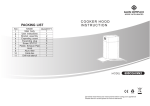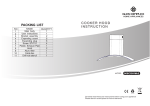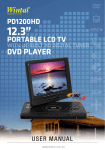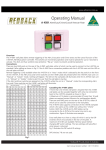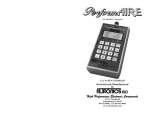Download BMS12 v1.2 - Zero Emission Vehicles Australia
Transcript
Zero Emission Vehicles Australia Protecting your Lithium Batteries http://www.zeva.com.au Lithium batteries have been a revolution in energy storage and a major enabling factor in the resurgence of electric vehicles. However they can be easily damaged if their voltage goes out of safe operating range – either too high (from overcharging) or too low (over-discharging). Battery packs are commonly built from a large number of individual cells in series to achieve higher voltages. Due to manufacturing tolerances, cells will always have some variation in capacity, so during use there will be some cells which get full or go flat before others. In battery packs made of many cells in series, the overall voltage gives little indication of the voltage of individual cells in the chain, so it is important to have a system which monitors the voltages of each cell, and takes action if any cell goes out of range. ZEVA’s BMS12 modules offer a robust, automotive-grade solution for protecting your lithium batteries from damage, maintaining pack balance, and monitoring cell voltages remotely. A single module can manage anywhere between 3–12 lithium cells, and up to 16 modules may be used on the same CAN bus allowing packs up to 192 cells or about 600VDC. The BMS12 modules communicate over CAN bus with a BMS master control unit to form a complete Battery Management System for your vehicle. Voltage thresholds are fully configurable, allowing the module to be compatible with most lithium chemistries including LiFePO4, LiCo, LiPo and LiMn. BMS12 Battery Management Systems should be considered the last line of defence for your battery pack. During normal operation, the BMS should never have to intervene with vehicle operation, only taking action to protect the battery in exceptional circumstances. Although a BMS will protect your cells from damage from over-discharging, regularly discharging your cells to 0% SoC – i.e driving until the BMS stops the vehicle – will drastically shorten the cycle life of your batteries so is best avoided whenever possible. v1.2 12-cell, CAN bus-enabled Lithium Battery Management Module Safety Warning Electric Vehicle battery packs contain a lot of energy and can deliver a lot of power, with potentially lethal voltages and currents. Proper precautions and electrical safety procedures should always be observed when working on EVs. Voltages above 110VDC should be considered dangerous, and vehicles should never be worked on while power contactor(s) are engaged. Please read this manual carefully to ensure correct installation and operation of your BMS12 modules. If you are unsure of anything, please contact us before proceeding. Please read these instructions carefully for proper installation and use of this product. We have endeavoured to make a safe and reliable product which performs as described, however since ZEVA has no control over the integration of its products into a vehicle, we can assume no responsibility for the safety or functionality of the completed vehicle. It is the responsibility of the end user to determine the suitability of the products for the purpose employed, and the end user assumes all risks associated. Products should only be installed by suitably qualified and experienced persons, and should always be used in a safe and lawful manner. 1 If cells are distributed in multiple groups around the vehicle, we do not recommend setting the BMS up as a fully centralised system (that is, with HV flyleads from every cell coming to a group of modules at a single location in the vehicle) because the long HV flyleads are subject to greater EMI noise and greater change of potentially dangerous wiring faults. Specifications • Cells managed: 3–12 lithium cells per module • Maximum total voltage: 60VDC • Compatible chemistries: LiFePO4, LiCo (LiPo), LiMn, etc • High, low and shunt voltage thresholds: Configurable, 0–5000mV • Accuracy: Within 0.25% (<10mV) • Operating temperature range: -40˚C to 85˚C • Pack balancing: Timed 30Ω shunts (~120mA, up to 1hr) • Temperature sensing: Dual 100KΩ NTC thermistors • Cell quiescent current draw: 1.6mA (idle) 2.2mA (when sampling) Once mounted, connect flywires between the 13-pin plug and the cells as per the diagram below, starting with the most negative (near the – sign) and working up to the most positive (near the + sign). It is best to leave the plug disconnected from the module while wiring up, and verify all voltages / cell orders before connecting to the module. If fewer than 12 cells are to be connected, some cell inputs at the positive end will be unused. These should be electrically bridged to the highest cell connection such that they are all at the same potential and will read as zero volts. Add this bridge before attaching any cells. • CAN power supply: 12V nominal (7-16V range), 20mA • CAN bus specification: 125kbps, 2.0A standard Shield Ground CAN L CAN H 12VDC • Dimensions: 80 x 76 x 10mm • Weight: 35g CAN BUS CAN BUS 12VDC CAN H CAN L Ground Shield Installation TEMP1 The module has four 3.2mm (1/8”) mounting holes at the corners as per the diagram below which can be used to securely mount the module. If fastening above metal surfaces, use standoffs or an insulating layer in between to ensure that the circuit board does not contact the metal, which could cause short circuits. Modules should be installed in a location protected from water and debris – typically, inside sealed battery enclosures is ideal. + 70mm TEMP2 ZEVA BMS1 v1.4 (c) 2014 – Most positive cell CAN BUS TEMP1 TEMP2 ZEVA BMS1 v1.4 (c) 2014 62mm 70mm CAN BUS Most negative cell Figure 2: Typical wiring for BMS12 module Figure 1: BMS12 module dimensions and mounting pattern The Molex C-Grid SL plugs are designed for fairly small gauge wire, around 24-30AWG. The wire’s insulation needs to be small enough to fit into the plug housing, which limits outer diameter to about 2mm. The best way to connect wires to pins is crimping first then adding a little solder to the joint. A suitable crimping tool is available from vendors such as Altronics (part T1537). It is best to mount the module close to the cells it is monitoring, with flylead lengths of 50cm or less recommended to minimise induced EMI noise and the chance of wiring/insulation faults. If you don’t have a suitable crimping tool, you can the solder wire directly to the plug, ensuring minimal gap between the insulation and the back of the pin. You may need to compress the wings on the pin insert a little for them to fit comfortably into the housing. – + 78mm 2 3 Operation Powering up (1) (2) The BMS12 modules run most of their circuitry from CAN bus power. When the module powers up, if there are no errors you should see a bright blue light on the board. This light may also indicate error codes as follows: (3) When the pin is fully inserted, a barb on the pin should engage a slot in the housing to lock it in place, and a faint click should be heard. Either inspect visually or give a gentle tug on the wire after insertion to ensure it is secure. Pins can be removed if necessary by applying pressure on the pin’s barb with a jeweler’s screwdriver, then the pin can be pulled from the housing. • Blinking once per second: No cells detected, or communication failure with cell sampler • Flashing twice per second: No CAN requests for over 1 second – possible CAN bus fault or no master control unit present. There are no visual signs of whether monitored cells are within range or if shunts are active. This must be monitored over CAN bus by an appropriate BMS master control unit, which is also able to take action in the event of a cell voltage or temperature error. Please refer to the user manual for your BMS master control unit for advice on integration with BMS12 modules. Be very careful to avoid short circuits or reverse polarities when attaching flyleads for the module, as lithium batteries can discharge dangerous current levels and wiring faults can damage the BMS12 module. Plugs for the CAN bus use 5-pin Molex C-Grid SL which are wired similarly to the cell connector. Shielded twisted pair cable is recommended for CAN bus wiring, with two conductor pairs – one pair for CAN signals, and one pair for bus power. (During operation, the traction circuit in electric vehicles can emit fairly high levels of electromagnetic interference, which can induce noise on signal wiring.) This type of wire is a little uncommon, but you can either purchase it from us or we can recommend vendors who may carry it in your part of the world. Your complete BMS should be “failsafe”, so if any BMS12 modules are not detected by the MCU on startup, or if any cells are out of safe voltage range, the vehicle should not be able to drive or be charged. It is a good idea to verify the failsafe by unplugging one of the flyleads to the cells or unplug the CAN bus, and verify that this causes the MCU to stop the charger or shut down the drive system. Note that the cell sampling electronics is galvanically isolated from the CAN bus electronics in order to maintain isolation between your traction circuit and vehicle chassis. There should also be no external electrical connections between HV wiring and CAN bus wiring. Voltage Thresholds BMS12 modules will come from the factory pre-programmed with voltage thresholds according to customer request/requirements (LiFePO4 by default), but the thresholds can also be reprogrammed anytime over CAN bus with an appropriate BMS master controller, or a ZEVA EVMS Monitor. The following table lists recommended voltage thresholds for Lithium Iron Phosphate (LiFePO4), Lithium Cobalt (LiCo) and Lithium Manganese (LiMn) cells. Ensure all wiring is secured so it will not become damaged from vibration or abrasion. BMS12 BMS12 – + B+ + – – + + – – + + – BMS12 – + – + + – – + + – – + + – – + + – – + + – – + + – MCU – + – + + – – + + – – + + – – + + – – + + – – + + – Figure 3: Example wiring for a 32-cell battery pack 4 Chemistry – + – + – + B- Nom Voltage Min Voltage Max Voltage Charge / Shunt Temp Range LiFePO4 3.2V 2.5V 3.8V 3.65V -20˚C – 60˚C LiCo 3.7V 3.0V 4.2V 4.0V -20˚C – 60˚C LiMn 3.7V 3.0V 4.2V 4.0V -20˚C – 40˚C 120! 120! For optimum performance, CAN buses should be wired as a single daisy chain of devices (without branching), and need to be terminated at both ends of the bus with a 120Ω resistor across the CAN H and CAN L lines. A suitable resistor has been included with the module, but should only be used with the final module in the chain. Modules and the MCU may be in any order on the CAN bus, and the MCU does not have to be an endpoint (it could be in the middle of the bus). Usually the CAN bus route requiring the shortest cable lengths is best. The diagram below shows an typical topology for an example 32-cell battery pack. To charger, contactors etc We recommend setting your charge voltage (per cell) and shunt voltage threshold to the same value. This way only high cells will shunt at the end of a charge cycle, and if the pack is perfectly balanced, no shunt balancing will occur. LiCo cells have the highest energy density but also the highest volatility and are often run very close to their safety limits. Cell manufacturers typically recommend charging to 4.2V, while cells can suffer damage above 4.3V. As such we recommend a slightly lower charge 5 voltage until you are confident that your pack is balanced to very close tolerances before charging to 4.2V/cell. (Due to the non-linear charge curve of lithium batteries, there is very little charge between 4.0V and 4.2V so minimal capacity is sacrificed.) Lithium Polymer (LiPo) actually refers to a type of construction rather than a chemistry, but the vast majority of cells marketed as LiPo are Lithium Cobalt (LiCo) chemistry. automatic Pack balancing In battery packs built from many cells, optimum performance is attained when all cells are at the same State of Charge – also known as pack balance. The BMS12 modules use a system known as “shunt balancing” to maintain balance, which switches on small resistors across any cells which go above a programmed shunt threshold. In this way cells with higher than average voltage will have some of their energy dissipated in order to bring their state of charge back down towards the average. The BMS12 uses a novel approach of small shunt resistors left on for a long time using timers, which keeps component size small and heat generated low, while still being able to balance a significant amount of energy each charge. Shunt balancers are not able to balance a pack completely in a single charge so we recommend manually balancing your cells prior to initial pack assembly (by charging each cell individually). However the shunts will get an unbalanced pack incrementally closer to balanced each charge, and once balanced are able to maintain perfect balance with minimal shunting. CAN Protocol Details For those wishing to integrate BMS12 modules with their own master control unit, we have prepared an application note detailing the required CAN format and packet IDs/structures. Please download a copy from the BMS12 product page at http://www.zeva.com.au. Tech support and warranty information BMS12 modules are covered by a 12 month warranty against manufacturing faults or failures under normal operating conditions. The warranty does not cover misuse of the product, including but not limited to physical damage or modification to the module, and reverse or excessive voltages to inputs. We have taken great care to design a safe and reliable product, but faults can happen. If you believe your BMS12 module has a fault, please contact us via our website for RMA information. Or if you have any questions not covered by this manual, please contact us via our website: http://www.zeva.com.au/Contact ZEVA is a carbon neutral business. All products proudly designed and manufactured in Australia. 6 7





